Napster has attained infamy for being the first program of its kind to really explode into the public consciousness. It was a P2P (Peer to Peer) file sharing service which allowed any user to easily share and download music files from other users: at the height of its popularity Napster had 80 million users. It was so popular among college students that dormitory internet became overloaded, with over 60% of the traffic consisting of MP3 file transfers.

Eventually a wave of lawsuits would shut down the service in 2001, but not before the concept of free-to-access music was firmly planted in the public consciousness. Today, torrent sites and P2P clients like SoulSeek provide the same functionality, but even better with an endless stream of lossless audio, video, and software.
One of Napster’s direct successors gained a more nefarious reputation, however. LimeWire was much like Napster in that it focused on ease of use and free media: it was designed to share video and software as well. By 2005 it had 1.7 million users. Its biggest flaw was the complete lack of content filtering and file verification: meaning many of the files were mislabeled, duds, or viruses.

